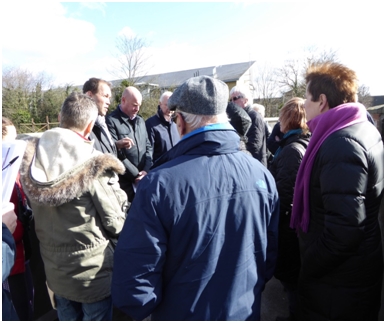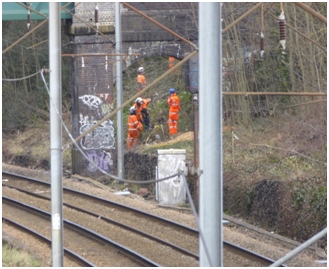Forum topic: Railside tree removals spark angry reaction
Railside tree removals spark angry reaction
PGC Webmaster
27 Feb 2015 18:26 #1032
- PGC Webmaster
-
 Topic starter
Topic starter
Share
![]()
![]() Share by email
Share by email
Palmers Green residents who are angry with the wholesale removal of trees from a trackside cutting have begun sending messages of protest to a Network Rail manager.
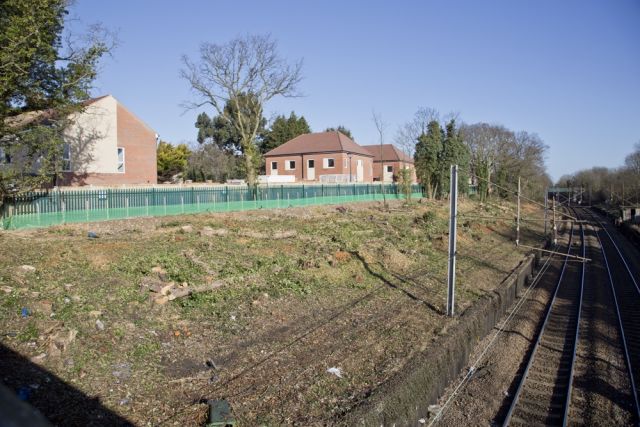 Complaints relate to a section of track adjacent to the Fox Lane bridge. On the western side of the cutting absolutely all trees and bushes have been removed along the section of track next to the new "Palmadium" housing development. Quite apart from the visual impact, there will be an obvious severe affect on wildlife and more train noise for Palmadium residents. It will also now be much easier for people to trespass on the railway line. There are also concerns about a risk of landslips onto the railway - as happened only recently in Warwickshire when trees were removed, leading to the closure of part of the Marylebone-Birmingham line until further notice.
Complaints relate to a section of track adjacent to the Fox Lane bridge. On the western side of the cutting absolutely all trees and bushes have been removed along the section of track next to the new "Palmadium" housing development. Quite apart from the visual impact, there will be an obvious severe affect on wildlife and more train noise for Palmadium residents. It will also now be much easier for people to trespass on the railway line. There are also concerns about a risk of landslips onto the railway - as happened only recently in Warwickshire when trees were removed, leading to the closure of part of the Marylebone-Birmingham line until further notice.
Example of a message sent to Network Rail executive Richard Owens ()
Hello Richard,
I’m sure you’ve received a few emails like this today and that there’ll be more to follow in the next few days, as a resident has provided before and after pictures for those of us trying to get to the bottom of the current clearance.
The flattened area around the Fox Lane bridge area highlights exactly the kind of wholesale destruction I was worried about when I contacted you earlier this month.
I’m sure there’s nothing you’ll say in response except that you were actioning the recommendations of an independent survey; though I’m still finding it hard to shake the conviction that Network Rail’s brief for the survey was something along the lines of ‘please highlight any and all possible threats, no matter how small, that might conceivably affect the lines for many years to come’.
Can all of these trees have posed a threat to the line? Really?
I realise also that Network Rail are in the privileged position of not being answerable to anyone - that much has been made abundantly clear. But please bear in mind that though you own the land around the tracks, the wildlife and trees there are part of our environment, and a little consideration for the feelings of residents when you’re planning this sort of excessive clearance might be worth considering. Would you tolerate this in your neighbourhood?
After Network Rail gave notice of the tree clearance project, attempts by Enfield Southgate MP David Burrows and others to forestall any particularly drastic interventions were unsuccessful - a reflection of Network Rail's privileged legal status with regard to the way it manages its land.
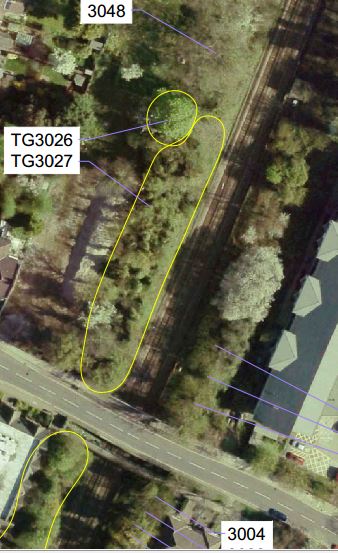 The arboriculturalists' report provided to Network Rail referred to two groups of trees at the point in question, using the reference TG3026 and TG3027.
The arboriculturalists' report provided to Network Rail referred to two groups of trees at the point in question, using the reference TG3026 and TG3027.
TG3026 referred to two horse chestnuts "displaying typical symptoms of horse chestnut bleeding canker infection, damage to lower stems becoming critical to continuation of life processes, embrittlement of scaffold limbs likely and failures certain to affect third party development at west".
TG3027 referred to a group of more than 35 sycamore and ash trees, about which the surveyors noted "Group features poor included, compressed stem unions, upon regrown stumps, with excessive ivy, poor form and reliance upon companion shelter.
The recommended action for both groups was "Fell" and this has clearly been followed, regardless of the local consequences.
The tree clearance work is due to continue for about three weeks. Other sections are less easily viewed from the road, so we do not know exactly what has happened elsewhere. Photographs taken from the footbridge further down the line from Fox Lane reveal some removal of trees, but they have not left the banks looking quite so bare and desolate.
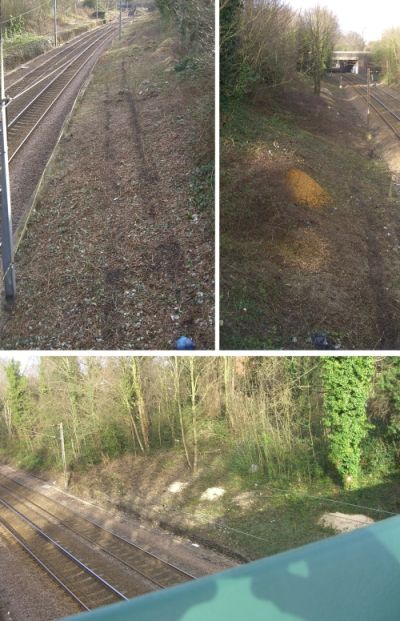 Views from the footbridge further north
Views from the footbridge further north
.
Please Log in or Create an account to join the conversation.
Railside tree removals spark angry reaction
Colin Younger
01 Mar 2015 17:04 #1033
- Colin Younger
-

Share
![]()
![]() Share by email
Share by email
An additional condition was the creation of "loggeries" for stag beetle larva to compensate for the removal of fallen timber on the site. In addition, I believe that the ecological report provided by the developers noted the area as being suitable for feeding bats because of the surrounding trees.
Network Rail's blitz has completly undermined these attempts to protect wildlife in the area, and compounded things by the removal of potential nesting and feeding sites for birds.
Private developers are forced to make some compensatory gestures, as in the Sherygreen project, but Network Rail seems able to carry on without any constraints or remedial action.
Please Log in or Create an account to join the conversation.
Railside tree removals spark angry reaction
Colin Younger
03 Mar 2015 23:58 #1038
- Colin Younger
-

Share
![]()
![]() Share by email
Share by email
I don’t think that we made much impression on Network Rail. They were confident that they had done even more on consultation than they were obliged to, and that all the work had been carried out in line with their arboriculturalist’s professional advice. They said that they might leave some of the felled tree trunks to provide habitat, and could re-visit the scene to consider whether there could be some replanting. However, again on advice from the arboriculturalist, they said that intended to put stump killer on the felled trees. This would of course prevent any regrowth, and ensure that the embankment remains bare and sterile. It was also claimed that full examination of the embankment had failed to find any evidence of frogs, toads, or newts.
Network Rail may of course be re-thinking their position, but given the lack of lasting effect from the protests and meetings held after the earlier mass clearance on the Grange Park embankment, this may be too optimistic. In the light of such continuing difficulty with Network Rail’s crude approach to embankment maintenance, consideration is now being given to linking with other protest groups and raising a national petition on this issue. I don’t think that anyone disputes the need for a maintenance programme, but the way it’s carried out is another matter.
Please Log in or Create an account to join the conversation.
Railside tree removals spark angry reaction
PGC Webmaster
04 Mar 2015 00:40 #1039
- PGC Webmaster
-
 Topic starter
Topic starter
Share
![]()
![]() Share by email
Share by email
Network Rail did commission an ecological survey (attached to this message), but there is a suggestion that tree felling had already begun before this was carried out.
The accusation against Network Rail is that they are overly focussed on train operation and minimising costs and pay scant regard to their responsibilities as stewarts of large tracts of land. By felling as many trees as possible they hope to be able to reduce the frequency with which they need to deal with trackside trees and vegetation. They are also excessively anxious to reduce the likelihood of their being held responsible for train delays due to tree falls etc because of the system of fines which is in force.
The problems are countrywide and go back to the time when Network Rail was set up. See this Parliamentary debate from 2003 about similar problems in Birmingham.
hansard.millbanksystems.com/westminster_hall/2003/jun/03/tree-management-network-rail
Please Log in or Create an account to join the conversation.
Railside tree removals spark angry reaction
David March
05 Mar 2015 11:13 #1045
- David March
-

Share
![]()
![]() Share by email
Share by email
As a result they inevitably react to tree 'problems' and clear the embankments - it's the cheapest option for them, but the most destructive from an environmental point of view. And it will go on like this until they are required to allocate funding for the preparation of these plans and to be more environmentally and publicly accountable for this. It's all down to money and whether there is a political will to address this.
At the very least, areas such as the embankment next to the 'Palmadium' site should be replanted with both trees and shrubs to an agreed design so that the 'green/wildlife corridor' is maintained.
Please Log in or Create an account to join the conversation.
Railside tree removals spark angry reaction
Colin Younger
05 Mar 2015 15:40 #1049
- Colin Younger
-

Share
![]()
![]() Share by email
Share by email
The London Plan 2014 (Draft) contains wording which is essentially a repeat of that in the 2011 plan. The draft says:
7.62 The richness of London’s biodiversity is also dependant on private gardens, parks and open spaces and green corridors along canals and railways as well as on the River Thames and its tributaries (Policy 7.29) that allow essential interconnection between London wildlife sites. The network formed by biodiversity sites and the spaces between them will have a significant role in assisting biodiversity to adapt to climate change. Further guidance on this is given in London Climate Change Partnership’s ‘Adapting to Climate Change: creating natural resilience’. Also Policy 2.18 recognises how green infrastructure can assist in enabling biodiversity to move to adapt effectively to the impacts
Green corridors are defined as follows:
This refers to relatively continuous areas of open space leading through the built environment, which may be linked and may not be publicly accessible. They may allow animals and plants to be found further into the built-up area than would otherwise be the case and provide an extension to the habitats of the sites they join.
The All London Green Grid 2011 (Supplementary Planning Guidance) says:
5.17 The Wood Green Link connects Clissold Park in the south to Finsbury Park and Alexandra Park to the north, continuing on through Wood Green to Palmers Green. Outside of these green spaces the link mainly passes through built-up areas.
This document defines Green Corridors as follows:
This refers to relatively continuous areas of open space leading through the built environment which may be linked and may not be publicly accessible (e.g. a railway embankment). They may allow movement of some animals and plants, and act as a conduit for species to reach further into urban areas that would otherwise be the case, and potentially provide extensions and connectivity to green spaces they join.
Though the corridor north of Palmers Green isn't specifically mentioned, the principle must surely be the same.
It seems clear to me that the rail embankment through Enfield is a green corridor as defined above. So the first question is "Is Network Rail immune from these planning policies?". If they are not immune, the next question is, "Who should be enforcing these policies?" Third, if Network Rail is immune from complying, the question must be "How can the immunity be removed?".
At the very least in order to comply with the spirit of these planning policies, Network Rail should halt work until a more sensitive managment plan can be adopted and a replanting proposal offered for consultation.
It's a sad reflection that the value of these green corridors is only fully appreciated when they are being destroyed.
Please Log in or Create an account to join the conversation.
Railside tree removals spark angry reaction
Karl Brown
06 Mar 2015 09:24 #1050
- Karl Brown
-

Share
![]()
![]() Share by email
Share by email
Please Log in or Create an account to join the conversation.



